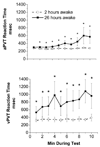Comparison of sustained attention assessed by auditory and visual psychomotor vigilance tasks prior to and during sleep deprivation
- PMID: 20819145
- PMCID: PMC3603691
- DOI: 10.1111/j.1365-2869.2010.00877.x
Comparison of sustained attention assessed by auditory and visual psychomotor vigilance tasks prior to and during sleep deprivation
Abstract
To date, no detailed examination of the pattern of change in reaction time performance for different sensory modalities has been conducted across the circadian cycle during sleep deprivation. Therefore, we compared sustained auditory and visual attention performance during 40h of sleep deprivation assessing multiple metrics of auditory and visual psychomotor vigilance tasks (PVT). Forty healthy participants (14 women) aged 30.8±8.6years were studied. Subjects were scheduled for an ∼8h sleep schedule at home prior to three-six laboratory baseline days with an 8 h sleep schedule followed by 40h sleep deprivation. Visual and auditory PVTs were 10min in duration, and were administered every 2h during sleep deprivation. Data were analysed with mixed-model anova. Sleep deprivation and circadian phase increased response time, lapses, anticipations, standard deviation of response times and time on task decrements for visual and auditory PVTs. In general, auditory vigilance was faster and less variable than visual vigilance, with larger differences between auditory and visual PVT during sleep deprivation versus baseline. Failures to respond to stimuli within 10s were four times more likely to occur to visual versus auditory stimuli. Our findings highlight that lapses during sleep deprivation are more than just long responses due to eye closure or visual distraction. Furthermore, our findings imply that the general pattern of change in attention during sleep deprivation (e.g. circadian variation, response slowing, lapsing and anticipations, time on task decrements and state instability) is similar among sensory-motor behavioral response modalities.
© 2010 European Sleep Research Society.
Figures



Similar articles
-
Now you hear me, now you don't: eyelid closures as an indicator of auditory task disengagement.Sleep. 2013 Dec 1;36(12):1867-74. doi: 10.5665/sleep.3218. Sleep. 2013. PMID: 24293761 Free PMC article.
-
Sustained attention performance during sleep deprivation associates with instability in behavior and physiologic measures at baseline.Sleep. 2014 Jan 1;37(1):27-39. doi: 10.5665/sleep.3302. Sleep. 2014. PMID: 24470693 Free PMC article.
-
Mood, alertness, and performance in response to sleep deprivation and recovery sleep in experienced shiftworkers versus non-shiftworkers.Chronobiol Int. 2012 Jun;29(5):537-48. doi: 10.3109/07420528.2012.675258. Chronobiol Int. 2012. PMID: 22621349
-
Increased Automaticity and Altered Temporal Preparation Following Sleep Deprivation.Sleep. 2015 Aug 1;38(8):1219-27. doi: 10.5665/sleep.4896. Sleep. 2015. PMID: 25845689 Free PMC article. Clinical Trial.
-
Sleep deprivation and vigilant attention.Ann N Y Acad Sci. 2008;1129:305-22. doi: 10.1196/annals.1417.002. Ann N Y Acad Sci. 2008. PMID: 18591490 Review.
Cited by
-
Using a Single Daytime Performance Test to Identify Most Individuals at High-Risk for Performance Impairment during Extended Wake.Sci Rep. 2019 Nov 13;9(1):16681. doi: 10.1038/s41598-019-52930-y. Sci Rep. 2019. PMID: 31723161 Free PMC article.
-
Now you hear me, now you don't: eyelid closures as an indicator of auditory task disengagement.Sleep. 2013 Dec 1;36(12):1867-74. doi: 10.5665/sleep.3218. Sleep. 2013. PMID: 24293761 Free PMC article.
-
Sleep Problems as Predictors in Attention-Deficit Hyperactivity Disorder: Causal Mechanisms, Consequences and Treatment.Clin Psychopharmacol Neurosci. 2017 Feb 28;15(1):9-18. doi: 10.9758/cpn.2017.15.1.9. Clin Psychopharmacol Neurosci. 2017. PMID: 28138105 Free PMC article. Review.
-
The Acute Effects of Intermittent Light Exposure in the Evening on Alertness and Subsequent Sleep Architecture.Int J Environ Res Public Health. 2018 Mar 15;15(3):524. doi: 10.3390/ijerph15030524. Int J Environ Res Public Health. 2018. PMID: 29543731 Free PMC article.
-
Staying vigilant during recurrent sleep restriction: dose-response effects of time-in-bed and benefits of daytime napping.Sleep. 2022 Apr 11;45(4):zsac023. doi: 10.1093/sleep/zsac023. Sleep. 2022. PMID: 35089345 Free PMC article.
References
-
- Anderson C, Horne JA. Sleepiness enhances distraction during a monotonous task. Sleep. 2006;29:573–576. - PubMed
-
- Arnedt JT, Owens J, Crouch M, Stahl J, Carskadon MA. Neurobehavioral performance of residents after heavy night call vs after alcohol ingestion. JAMA. 2005;294:1025–1033. - PubMed
-
- Badia P, Harsh J, Balkin T, Cantrell P, Klempert A, O'Rourke D, Schoen L. Behavioral control of respiration in sleep. Psychophysiol. 1984;21:494–500. - PubMed
-
- Belenky G, Wesensten NJ, Thorne DR, Thomas ML, Sing HC, Redmond DP, Russo MB, Balkin TJ. Patterns of performance degradation and restoration during sleep restriction and subsequent recovery: a sleep dose-response study. J. Sleep Res. 2003;12:1–12. - PubMed
Publication types
MeSH terms
Grants and funding
LinkOut - more resources
Full Text Sources

